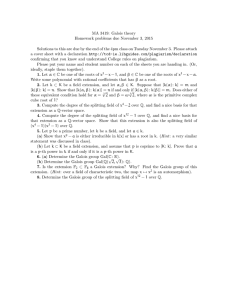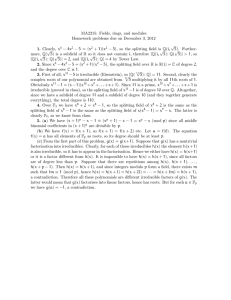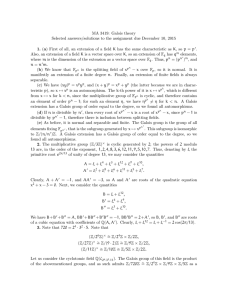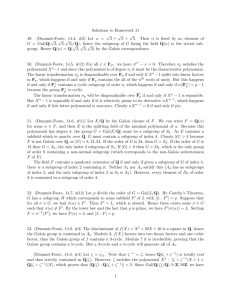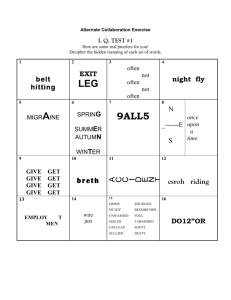MA 3419: Galois theory √ 1. Roots of x
advertisement
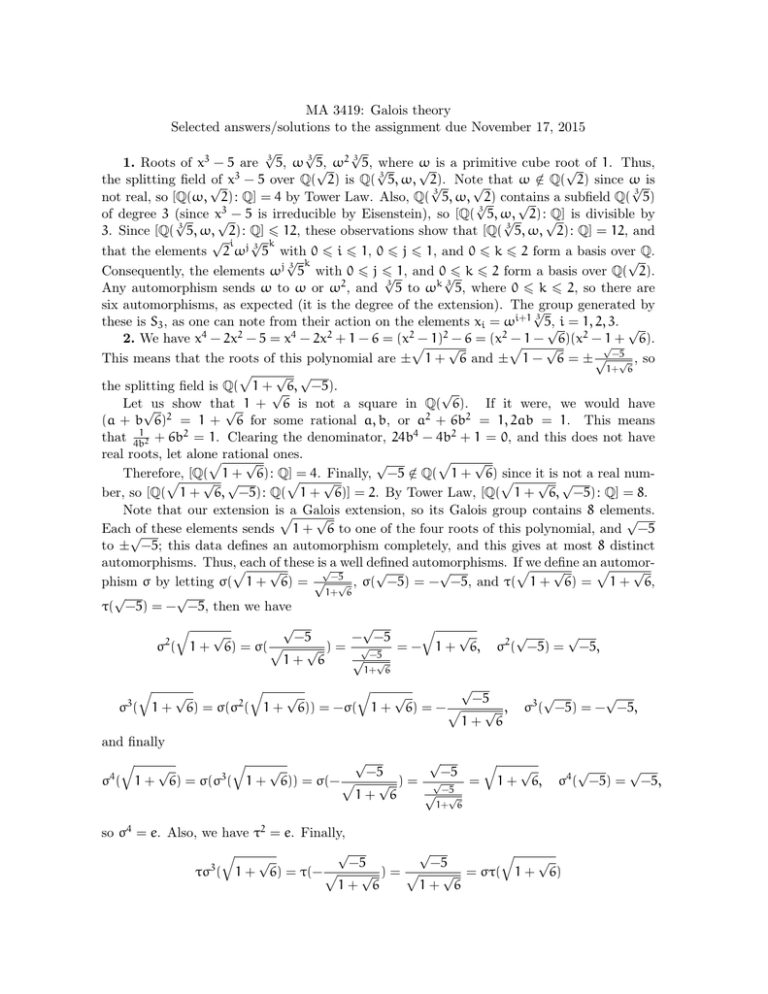
MA 3419: Galois theory Selected answers/solutions to the assignment due November 17, 2015 √ √ √ ω2 3 5, √ where √ ω is a primitive cube root 1. Roots of x3 − 5 are 3 5, ω 3 5, √ √ of 1. Thus, the splitting field √ of x3 − 5 over Q( 2) is Q( 3 5, ω, 2). Note that ω ∈ / Q( 2) since ω is √ √ √ 3 3 not real, so [Q(ω, 2) : Q] = 4 by Tower Law. Also, Q( 5, ω, √2) contains a subfield Q( 5) √ 3 − 5 is irreducible by Eisenstein), so [Q( 3 5, ω, 2) : Q] is divisible by of degree 3 (since x √ √ √ √ 3. Since [Q( 3 5, ω, 2) : Q] 6 12, these observations show that [Q( 3 5, ω, 2) : Q] = 12, and √ i √ k that the elements 2 ωj 3 5 with 0 6 i 6 1, 0 6 j 6 1, and 0 6 k 6 2 form a basis over Q. √ k √ Consequently, the elements ωj 3 5 with 0 6 j 6 1, and 0√6 k 6 2 form a basis over Q( 2). √ Any automorphism sends ω to ω or ω2 , and 3 5 to ωk 3 5, where 0 6 k 6 2, so there are six automorphisms, as expected (it is the degree of the extension). The√group generated by these is S3 , as one can note from their action on the elements xi = ωi+1 3 5, √ i = 1, 2, 3. √ 2. We have x4 − 2x2 − 5 = x4 − 2x2 + 1 − 6 = (x2p − 1)2 − 6 = (x2 p − 1 − 6)(x2 − √ 1 + 6). √ √ This means that the roots of this polynomial are ± 1 + 6 and ± 1 − 6 = ± √ −5√ , so 1+ 6 p √ √ the splitting field is Q( 1 +√ 6, −5). √ Let√us show that 1 + 6 is not a square in Q( 6). If it were, we would have √ (a + b 6)2 = 1 + 6 for some rational a, b, or a2 + 6b2 = 1, 2ab = 1. This means that 4b12 + 6b2 = 1. Clearing the denominator, 24b4 − 4b2 + 1 = 0, and this does not have real roots, let alone ones. prational p √ √ √ Therefore, [Q( 1 + 6) : Q] = 4. Finally, −5 ∈ / Q( 1 + 6) p since it is not a real nump p √ √ √ √ √ ber, so [Q( 1 + 6, −5) : Q( 1 + 6)] = 2. By Tower Law, [Q( 1 + 6, −5) : Q] = 8. Note that our extension ispa Galois extension, so its Galois group contains 8 elements. √ √ Each√of these elements sends 1 + 6 to one of the four roots of this polynomial, and −5 to ± −5; this data defines an automorphism completely, and this gives at most 8 distinct automorphisms. Thus,peach of these is√a well defined automorphisms. Ifpwe define anp automor√ √ √ √ √ phism σ by letting σ( 1 + 6) = √ −5√ , σ( −5) = − −5, and τ( 1 + 6) = 1 + 6, 1+ 6 √ √ τ( −5) = − −5, then we have √ √ q q √ √ √ √ −5 − −5 2 2 σ ( 1 + 6) = σ( p √ ) = √−5 = − 1 + 6, σ ( −5) = −5, √ √ 1+ 6 1+ 6 √ q q q √ √ √ −5 2 σ ( 1 + 6) = σ(σ ( 1 + 6)) = −σ( 1 + 6) = − p √ , 1+ 6 3 √ √ σ3 ( −5) = − −5, and finally √ √ q q q √ √ √ −5 −5 4 3 σ ( 1 + 6) = σ(σ ( 1 + 6)) = σ(− p √ ) = √−5 = 1 + 6, √ √ 1+ 6 √ √ σ4 ( −5) = −5, 1+ 6 so σ4 = e. Also, we have τ2 = e. Finally, √ √ q q √ √ −5 −5 3 τσ ( 1 + 6) = τ(− p √ )= p √ = στ( 1 + 6) 1+ 6 1+ 6 √ √ √ and τσ3 ( −5) = −5 = στ( −5). This means that στ = τσ3 , and altogether σ and τ generate the dihedral group D4 of 8√elements, which is therefore the Galois group. 3. The splitting field of f is Q( 4 3, i), by a standard argument it is√a field of degree 8. √ 4 4 Each Galois group element is completely determined by the action on 3 and on i: 3 is √ 4 l sent to i 3, and i is sent to ±i. If we consider in the complex plane the square formed by the roots of x4 − 3, then the Galois group action on the roots is manifestly the dihedral group √ √ 4 4 D4 action by symmetries of that square: the element σ for which σ( √ 3) = i√ 3, σ(i) = i, implements the rotation of the square, while the element τ for which τ( 4 3) = 4 3, τ(i) = −i implements the reflection about the diagonal. Subgroups of D4 are: four subgroups generated by the reflections τ, στ, σ2 τ, σ3 τ, the subgroup of order 2 generated by σ2 , the subgroup of order 4 generated by σ, and the two Klein 4-groups generated by σ2 and √ τ and by σ2 and στ. The invariant subfield of the 2 subgroup generated √ by σ and τ is Q( 3), the invariant subfield of the subgroup generated by σ2 and στ is Q(i 3), the invariant subfield of the subgroup generated by σ is Q(i), the √ 2 invariant subfield of the subgroup √ generated by σ is Q( 3, i), the invariant subfield of the by στ is subgroup√generated by τ is Q( 4 3), the invariant subfield of the subgroup generated √ 2 τ is Q(i 4 3), the invariant Q((1+i) 4 3), the invariant subfield of the subgroup generated by σ √ subfield of the subgroup generated by σ3 τ is Q((1 − i) 4 3). Some remarks on finding invariant subfields: If k ⊂ F ⊂ K is a tower where k ⊂ K is a Galois extension, then we know that F ⊂ K is a Galois extension too. Thus, # Gal(K : k) = [K : k], # Gal(K : F) = [K : F], so by Tower Law [F : k] is the index of the subgroup Gal(K : F) of the group Gal(K : k). Therefore, two-element subgroups correspond to degree four extensions, and the four-element subgroups correspond to quadratic extensions. Now, some of the extensions above are fixed by the √ corresponding subgroups by direct inspection of definitions of σ and τ. Some, like Q((1 + i) 4 3), are obtained as follows: the element λ = στ is of order 2, so for 2 each a, the √ element a + λ(a) is λ-invariant, since √ λ(a + λ(a)) = λ(a) + λ (a) = λ(a) + a. 4 Taking a = 3, we get the element u = (1 + i) 43. It generates a degree 4 extension, since u4 = −12, and the polynomial x4 + 12 is irreducible by Eisenstein (p = 3).√ 4. In F5 , we have 32 6= 1, 34 = 1. This means that the element x = 4 3 in the splitting field of x4 − 3 is of order 16 in the multiplicative group of that field. That splitting field is of characteristic 5, so its multiplicative group has 5k − 1 elements, where k is the degree of the extension. By Lagrange’s theorem, 16 divides 5k − 1, so k 6= 1, 2, 3, thus k > 4. Also, F5 has four distinct fourth roots of 1, so adjoining one root of x4 − 3 gives the splitting field. This implies that x4 − 3 is irreducible, and that the Galois group is the cyclic group of order 4 of fourth roots of 1 in F5 . √ In F7 , we have 36 = 1, 3k 6= 1 for 0 < k < 6. This means that the element x = 4 3 in the splitting field of x4 − 3 is of order 24 in the multiplicative group of that field. That splitting field is of characteristic 7, so its multiplicative group has 7k − 1 elements, where k is the degree of the extension. Thus, it is possible√that k = 2 would work. Let us consider √ √ 2 the √ a square, since (a + b 3) = 3 quadratic extension F7 ( 3). In this extension, 3 is in fact √ 2 has a solution a = 1, b = 4. Also, in that extension, (3 3) = 27 = −1, so that extension √ has four distinct fourth roots of −1: ±1 and ±3 3. We conclude that the splitting field is F49 and the Galois group is the cyclic group of order 2. √ In F11 , we have 35 = 1, 3k 6= 1 for 0 < k < 5. This means that the element x = 4 3 in the splitting field of x4 − 3 is of order 20 in the multiplicative group of that field. That splitting field is of characteristic 11, so its multiplicative group has 11k − 1 elements, where k is the degree of the extension. Thus, it is possible that k = 2 would work. Note that 52 = 25 = 3 √ in F11 , so F11 ( 4 3) is a quadratic extension. All fields of 121 elements are isomorphic, so that √ extension also contains i = −1, and hence the four distinct fourth roots of 1. We conclude that the splitting field is F121 and the Galois group is the cyclic group of order 2. Over F13 , our polynomial splits: x4 − 3 = (x − 2)(x + 2)(x − 3)(x + 3), so the splitting field is F13 , and the Galois group is trivial. 5. K = k(a) if and only if k(a) is not a proper subfield of K, which happens if and only if it is not a fixed field of a nontrivial subgroup of G, which happens if and only if the only element which fixes a is e, which happens if and only if g1 (a), . . . , gn (a) are distinct elements of K.

